Object Hierarchy and Inheritance in JavaScript
This paper assumes that you're already somewhat familiar with JavaScript and that you have used JavaScript functions to create simple objects. For information on this subject, see Chapter 10, "Object Model," in the JavaScript Guide.
The sections in this paper are:
Employee class could represent the set of all employees. An instance, on the other hand, is the instantiation of a class; that is, one of its members. For example, Victoria could be an instance of the Employee class, representing a particular individual as an employee. An instance has exactly the properties of its parent class (no more, no less). A prototype-based language, such as JavaScript, does not make this distinction: it simply has objects. A prototype-based language has the notion of a prototypical object, an object used as a template from which to get the initial properties for a new object. Any object can specify its own properties, either when you create it or even at runtime. In addition, any object can be associated as the prototype for another object, allowing the second object to share the first object's properties.
In class-based languages, you define a class in a separate class definition. In that definition you can specify special methods, called constructors, to use to create instances of the class. A constructor method can specify initial values for the instance's properties and perform other processing appropriate at creation time. You use the new operator in association with the constructor method to create class instances.
JavaScript follows a similar model, but does not have a class definition separate from the constructor. Instead, you define a constructor function to create objects with a particular initial set of properties and values. Any JavaScript function can be used as a constructor. You use the new operator with a constructor function to create a new object.
In a class-based language, you create a hierarchy of classes through the class definitions. In a class definition, you can specify that the new class is a subclass of an already existing class. The subclass inherits all the properties of the superclass and additionally can add new properties or modify the inherited ones. For example, assume the
Employee class includes only name and dept properties and Manager is a subclass of Employee that adds the reports property. In this case, an instance of the Manager class would have all three properties: name, dept, and reports. JavaScript implements inheritance by allowing you to associate a prototypical object with any constructor function. So, you can create exactly the
Employee-Manager example, but you use slightly different terminology. First you define the Employee constructor function, specifying the name and dept properties. Next, you define the Manager constructor function, specifying the reports property. Finally, you assign a new Employee object as the prototype for the Manager constructor function. Then, when you create a new Manager, it inherits the name and dept properties from the Employee object. In class-based languages, you typically create a class at compile time and then you instantiate instances of the class either at compile time or at runtime. You cannot change the number or the type of properties of a class after you define the class. In JavaScript, however, at runtime you can add or remove properties from any object. If you add a property to an object that is used as the prototype for a set of objects, the objects for which it is the prototype also get the new property.
Table 1 gives a short summary of some of these differences. The rest of this paper describes the details of using JavaScript constructors and prototypes to create an object hierarchy and compares this to how you would do it in Java.
Table 1 Comparison of class-based (Java) and prototype-based (JavaScript) object systems
The Employee Example
The rest of this paper works with the simple employee hierarchy shown in Figure 1.Figure 1 A simple object hierarchy

Employeehas the propertiesname(whose value defaults to the empty string) anddept(whose value defaults to"general").Manageris based onEmployee. It adds thereportsproperty (whose value defaults to an empty array, intended to have an array ofEmployeeobjects as its value).WorkerBeeis also based onEmployee. It adds theprojectsproperty (whose value defaults to an empty array, intended to have an array of strings as its value).SalesPersonis based onWorkerBee. It adds thequotaproperty (whose value defaults to 100). It also overrides thedeptproperty with the value"sales", indicating that all salespersons are in the same department.Engineeris based onWorkerBee. It adds themachineproperty (whose value defaults to the empty string) and also overrides thedeptproperty with the value"engineering".Creating the Hierarchy
There are several ways you can define appropriate constructor functions to implement the Employee hierarchy. How you choose to define them depends largely on what you want to be able to do in your application. We'll get into all that later.
For now, let's use very simple (and comparatively inflexible) definitions just to see how we get the inheritance to work. In these definitions, you can't specify any property values when you create an object. The newly-created object simply gets the default values, which you can change at a later time. Figure 2 illustrates the hierarchy with these simple definitions.
In a real application, you would probably define constructors that allow you to provide property values at object creation time. Options for doing so are described later in "More Flexible Constructors". For now, these simple definitions let us look at how the inheritance occurs.
Figure 2 What the definitions look like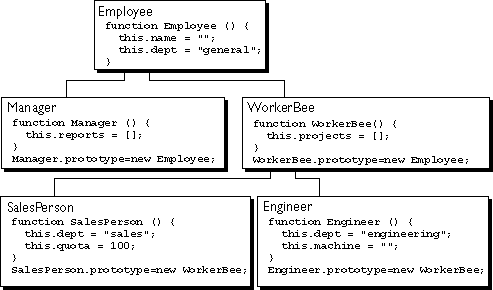
The simple Java and JavaScriptEmployeedefinitions below are similar. The only difference is that you need to specify the type for each property in Java but not in JavaScript and you need to create an explicit constructor method for the Java class.
JavaScriptJava function Employee () {
this.name = "";
this.dept = "general";
}public class Employee {
public String name;
public String dept;
public Employee () {
this.name = "";
this.dept = "general";
}
}
TheManagerand WorkerBee definitions show the difference in how you specify the next object higher in the inheritance chain. In JavaScript, you add a prototypical instance as the value of theprototypeproperty of the constructor function. You can do so at any time after you define the constructor. In Java, you specify the superclass within the class definition. You cannot change the superclass outside the class definition.
JavaScript
TheEngineerandSalesPersondefinitions create objects that descend fromWorkerBeeand hence fromEmployee. An object of these types has properties of all the objects above it in the chain. In addition, these definitions override the inherited value of thedeptproperty with new values specific to these objects.
JavaScript
Using these definitions, you can create instances of these objects that get the default values for their properties. Figure 3 illustrates using these JavaScript definitions to create new objects and shows the property values for the new objects.NOTE: As described earlier, the term instance has a specific technical meaning in class-based languages. In these languages, an instance is an individual member of a class and is fundamentally different from a class. In JavaScript, "instance" does not have this technical meaning because JavaScript does not have this difference between classes and instances. However, in talking about JavaScript, "instance" can be used informally to mean an object created using a particular constructor function. So, in this example, you could informally say that
Figure 3 Creating objects with the simple definitionsjaneis an instance ofEngineer. Similarly, although the terms parent, child, ancestor, and descendant do not have formal meanings in JavaScript, we can use them informally to refer to objects higher or lower in the prototype chain.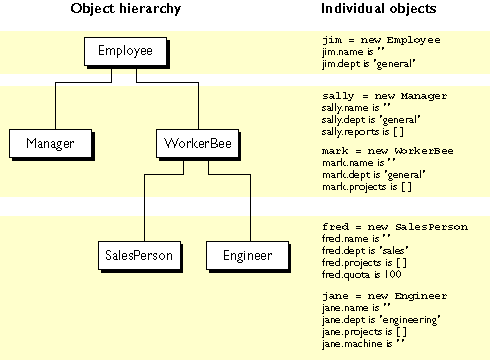
Object Properties
This section discusses how objects inherit properties from other objects in the prototype chain and what happens when you add a property at runtime.Inheriting Properties
Assume you create themarkobject as aWorkerBeeas shown in Figure 3 with this statement:mark = new WorkerBee;
When JavaScript sees thenewoperator, it creates a new generic object and passes this new object as the value of thethiskeyword to theWorkerBeeconstructor function. The constructor function explicitly sets the value of theprojectsproperty. It also sets the value of the internal__proto__property to the value ofWorkerBee.prototype. (That property name has 2 underscore characters at the front and 2 at the end.) The__proto__property determines the prototype chain used to return property values. Once these properties are set, JavaScript returns the new object and the assignment statement sets the variablemarkto that object.
This process doesn't explicitly put values in themarkobject (local values) for the propertiesmarkinherits from the prototype chain. When you ask for the value of a property, JavaScript first checks to see if the value exists in that object. If it does, that value is returned. If the value isn't there locally, JavaScript checks the prototype chain (using the__proto__property). If an object in the prototype chain has a value for the property, that value is returned. If no such property is found, JavaScript says the object doesn't have the property. In this way, themarkobject has the following properties and values:mark.name = "";
The
mark.dept = "general";
mark.projects = [];markobject inherits values for thenameanddeptproperties from the prototypical object inmark.__proto__. It is assigned a local value for theprojectsproperty by theWorkerBeeconstructor. Simply put, this gives you inheritance of properties and their values in JavaScript. Some subtleties of this process are discussed in "Property Inheritance Revisited".
Because these constructors don't let you supply instance-specific values, this information is generic. The property values are the default ones shared by all new objects created fromWorkerBee. You can, of course, change the values of any of these properties. So, you could give specific information formarkas shown here:mark.name = "Doe, Mark";
mark.dept = "admin";
mark.projects = ["navigator"];Adding Properties
In JavaScript at runtime you can add properties to any object. You are not constrained to use only the properties provided by the constructor function. To add a property that is specific to a single object, you simply assign a value to the object, as in:mark.bonus = 3000;
Now, themarkobject has abonusproperty, but no otherWorkerBeehas this property.
If you add a new property to an object that is being used as the prototype for a constructor function, you add that property to all objects that inherit properties from the prototype. For example, you can add aspecialtyproperty to all employees with the following statement:Employee.prototype.specialty = "none";
As soon as JavaScript executes this statement, themarkobject also has thespecialtyproperty with the value of"none". Figure 4 shows the effect of adding this property to theEmployeeprototype and then overriding it for theEngineerprototype.
Figure 4 Adding properties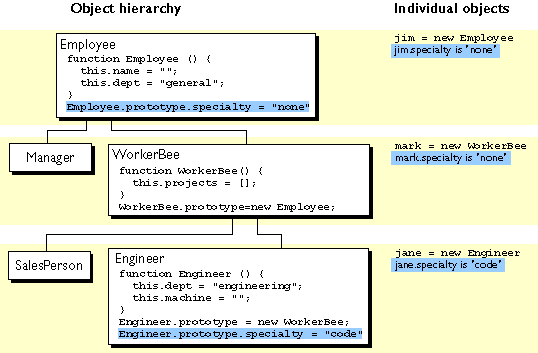
More Flexible Constructors
The constructor functions used so far do not let you specify property values when you create an instance. As with Java, you can provide arguments to constructors to initialize property values for instances. Figure 5 shows one way to do this.
Figure 5 Specifying properties in a constructor, take 1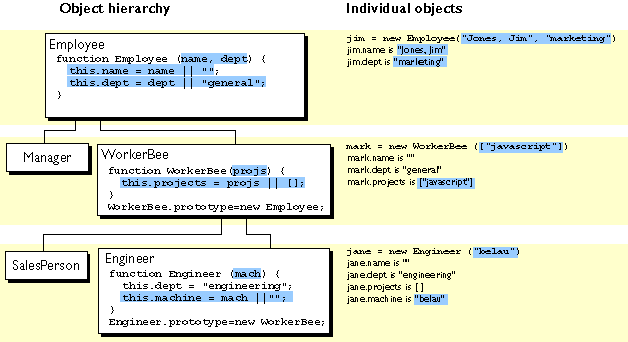
Here are the Java and JavaScript definitions for these objects.
JavaScript
These JavaScript definitions use a special idiom for setting default values:this.name = name || "";
The JavaScript logical OR operator (||) evaluates its first argument. If that argument is converts to true, the operator returns it. Otherwise, the operator returns the value of the second argument. Therefore, this line of code tests to see ifnamehas a useful value for thenameproperty. If it does, it setsthis.nameto that value. Otherwise, it setsthis.nameto the empty string. This paper uses this idiom for brevity; however, it can be puzzling at first glance.
With these definitions, when you create an instance of an object, you can specify values for the locally defined properties. As shown in Figure 5, you can use this statement to create a newEngineer:jane = new Engineer("belau");Jane's properties are now:jane.name == "";
Notice that with these definitions, you cannot specify an initial value for an inherited property such as
jane.dept == "general";
jane.projects == [];
jane.machine == "belau"name. If you want to specify an initial value for inherited properties in JavaScript, you need to add more code to the constructor function.
So far, the constructor function has created a generic object and then specified local properties and values for the new object. You can have the constructor add more properties by directly calling the constructor function for an object higher in the prototype chain. Figure 6 shows these new definitions.
Figure 6 Specifying properties in a constructor, take 2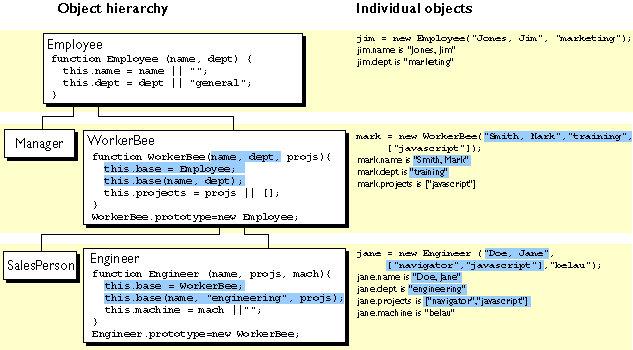
Let's look at one of these definitions in detail. Here's the new definition for theEngineerconstructor:function Engineer (name, projs, mach) {Assume we create a new
this.base = WorkerBee;
this.base(name, "engineering", projs);
this.projects = mach || "";
}Engineerobject as follows:jane = new Engineer("Doe, Jane", ["navigator", "javascript"], "belau");JavaScript follows these steps:1. First, the
newoperator creates a generic object and sets its__proto__property toEngineer.prototype.2. The
newoperator then passes the new object to theEngineerconstructor as the value of thethiskeyword.3. Next, the constructor creates a new property called
basefor that object and assigns the value of theWorkerBeeconstructor to thebaseproperty. This makes theWorkerBeeconstructor a method of theEngineerobject.NOTE: The name of the
baseproperty is not special. You can use any legal property name;baseis simply evocative of its purpose.4. Next, the constructor calls the
basemethod, passing as its arguments two of the arguments passed to the constructor ("Doe, Jane"and["navigator", "javascript"]) and also the string"engineering". Explicitly using"engineering"in the constructor indicates that allEngineerobjects have the same value for the inheriteddeptproperty and this value overrides the value inherited fromEmployee.5. Because
baseis a method ofEngineer, within the call tobase, JavaScript binds thethiskeyword to the object created in step 1. Thus, theWorkerBeefunction in turn passes the"Doe, Jane"and["navigator", "javascript"]arguments to theEmployeeconstructor function. Upon return from theEmployeeconstructor function, theWorkerBeefunction uses the remaining argument to set theprojectsproperty.6. Upon return from the
basemethod, theEngineerconstructor initializes the object'smachineproperty to"belau".7. Upon return from the constructor, JavaScript assigns the new object to the
You might think that, having called thejanevariable.WorkerBeeconstructor from inside theEngineerconstructor, you've set up inheritance appropriately forEngineerobjects. This is not the case. Calling theWorkerBeeconstructor ensures that anEngineerobject starts out with the properties specified in all constructor functions that are called. However, if you later add properties to theEmployeeorWorkerBeeprototypes, those properties are not inherited by theEngineerobject. For example, assume you have these statements:function Engineer (name, projs, mach) {The
this.base = WorkerBee;
this.base(name, "engineering", projs);
this.projects = mach || "";
}
jane = new Engineer("Doe, Jane", ["navigator", "javascript"], "belau");
Employee.prototype.specialty = "none";janeobject does not inherit thespecialtyproperty. You still need to explicitly set up the prototype to ensure dynamic inheritance. Assume instead you have these statements:function Engineer (name, projs, mach) {Now the value of the
this.base = WorkerBee;
this.base(name, "engineering", projs);
this.projects = mach || "";
}
Engineer.prototype = new WorkerBee;
jane = new Engineer("Doe, Jane", ["navigator", "javascript"], "belau");
Employee.prototype.specialty = "none";janeobject'sspecialtyproperty is"none".Property Inheritance Revisited
The preceding sections have described how constructors and prototypes provide hierarchies and inheritance in JavaScript. As with all languages, there are some subtleties that were not necessarily apparent in these earlier discussions. This section discusses some of those subtleties.Local versus Inherited Values
Let's revisit property inheritance briefly. As discussed earlier, when you access an object property, JavaScript performs these steps:-
- Check to see if the value exists locally. If it does, return that value.
- If there isn't a local value, check the prototype chain (using the
__proto__property). - If an object in the prototype chain has a value for the specified property, return that value.
- If no such property is found, the object does not have the property.
function Employee () {
this.name = "";
this.dept = "general";
}function WorkerBee () {With these definitions, assume you create
this.projects = [];
}
WorkerBee.prototype = new Employee;amyas an instance ofWorkerBeewith this statement:amy = new WorkerBee;
Theamyobject has one local property,projects. The values for thenameanddeptproperties are not local toamyand so are gotten from theamyobject's__proto__property. Thus,amyhas these property values:amy.name == "";
Now assume you change the value of the
amy.dept = "general";
amy.projects == [];nameproperty in the prototype associated withEmployee:Employee.prototype.name = "Unknown"
At first glance, you might expect that new value to propagate down to all the instances ofEmployee. However, it does not.
When you create any instance of theEmployeeobject, that instance gets a local value for thenameproperty (the empty string). This means that when you set theWorkerBeeprototype by creating a newEmployeeobject,WorkerBee.prototypehas a local value for thenameproperty. Therefore, when JavaScript looks up thenameproperty of theamyobject (an instance ofWorkerBee), JavaScript finds the local value for that property inWorkerBee.prototype. It therefore does not look farther up the chain toEmployee.prototype.
If you want to change the value of an object property at runtime and have the new value be inherited by all descendants of the object, you cannot define the property in the object's constructor function. Instead, you add it to the constructor's associated prototype. For example, assume you change the code above to the following:function Employee () {
this.dept = "general";
}
Employee.prototype.name = "";function WorkerBee () {
this.projects = [];
}
WorkerBee.prototype = new Employee;amy = new WorkerBee;
Employee.prototype.name = "Unknown";
In this case, thenameproperty ofamybecomes"Unknown".
As these examples show, if you want to have default values for object properties and you want to be able to change the default values at runtime, you should set the properties in the constructor's prototype, not in the constructor function itself.Determining Instance Relationships
You may want to know what objects are in the prototype chain for an object, so that you can tell from what objects this object inherits properties. In a class-based language, you might have aninstanceofoperator for this purpose. JavaScript does not provideinstanceof, but you can write such a function yourself.
As discussed in "Inheriting Properties", when you use thenewoperator with a constructor function to create a new object, JavaScript sets the__proto__property of the new object to the value of theprototypeproperty of the constructor function. You can use this to test the prototype chain.
For example, assume you have the same set of definitions we've been using, with the prototypes set appropriately. Create an__proto__object as follows:chris = new Engineer("Pigman, Chris", ["jsd"], "fiji");With this object, the following statements are all true:chris.__proto__ == Engineer.prototype;
Given this, you could write an
chris.__proto__.__proto__ == WorkerBee.prototype;
chris.__proto__.__proto__.__proto__ == Employee.prototype;
chris.__proto__.__proto__.__proto__.__proto__ == Object.prototype;
chris.__proto__.__proto__.__proto__.__proto__.__proto__ == null;instanceOffunction as follows:function instanceOf(object, constructor) {With this definition, the following expressions are all true:
while (object != null) {
if (object == constructor.prototype)
return true;
object = object.__proto__;
}
return false;
}instanceOf (chris, Engineer)
But this expression is false:
instanceOf (chris, WorkerBee)
instanceOf (chris, Employee)
instanceOf (chris, Object)instanceOf (chris, SalesPerson)
Global Information in Constructors
When you create constructors, you need to be careful if you set global information in the constructor. For example, assume that you want a unique ID to be automatically assigned to each new employee. You could use this definition forEmployee:var idCounter = 1;
function Employee (name, dept) {With this definition, when you create a new
this.name = name || "";
this.dept = dept || "general";
this.id = idCounter++;
}Employee, the constructor assigns it the next ID in sequence and then increments the global ID counter. So, if your next statement were:victoria = new Employee("Pigbert, Victoria", "pubs")
harry = new Employee("Tschopik, Harry", "sales")victoria.idis 1 andharry.idis 2. At first glance that seems fine. However,idCountergets incremented every time anEmployeeobject is created, for whatever purpose. If you create the entireEmployeehierarchy we've been working with, theEmployeeconstructor is called every time we set up a prototype. That is, assume you have this code:var idCounter = 1;
function Employee (name, dept) {
this.name = name || "";
this.dept = dept || "general";
this.id = idCounter++;
}function Manager (name, dept, reports) {...}
Manager.prototype = new Employee;function WorkerBee (name, dept, projs) {...}
WorkerBee.prototype = new Employee;function Engineer (name, projs, mach) {...}
Engineer.prototype = new WorkerBee;function SalesPerson (name, projs, quota) {...}
SalesPerson.prototype = new WorkerBee;mac = new Engineer("Wood, Mac");Further assume that the definitions we've omitted here have thebaseproperty and call the constructor above them in the prototype chain. In this case, by the time themacobject is created,mac.idis 5.
Depending on the application, it may or may not matter that the counter has been incremented these extra times. If you care about the exact value of this counter, one possible solution involves instead using this constructor:function Employee (name, dept) {When you create an instance of
this.name = name || "";
this.dept = dept || "general";
if (name)
this.id = idCounter++;
}Employeeto use as a prototype, you do not supply arguments to the constructor. Using this definition of the constructor, when you do not supply arguments, the constructor does not assign a value to the id and does not update the counter. Therefore, for anEmployeeto get an assigned id, you must specify a name for the employee. In our example,mac.idwould be 1.No Multiple Inheritance
Some object-oriented languages allow multiple inheritance. That is, an object can inherit the properties and values from unrelated parent objects. JavaScript does not support multiple inheritance.
As we've already said, inheritance of property values occurs at runtime by JavaScript searching the prototype chain of an object to find a value. Because an object has a single associated prototype, JavaScript cannot dynamically inherit from more than one prototype chain.
In JavaScript you can have a constructor function call more than one other constructor function within it. This gives the illusion of multiple inheritance. For example, consider the following statements:function Hobbyist (hobby) {
this.hobby = hobby || "scuba";
}function Engineer (name, projs, mach, hobby) {
this.base1 = WorkerBee;
this.base1(name, "engineering", projs);
this.base2 = Hobbyist;
this.base2(hobby);
this.projects = mach || "";
}
Engineer.prototype = new WorkerBee;dennis = new Engineer("Doe, Dennis", ["collabra"], "hugo")Further assume that the definition ofWorkerBeeis as we've previously seen it. In this case, the dennis object has these properties:dennis.name == "Doe, Dennis"
So
dennis.dept == "engineering"
dennis.projects == ["collabra"]
dennis.machine == "hugo"
dennis.hobby == "scuba"dennisdoes get thehobbyproperty from theHobbyistconstructor. However, assume you then add a property to theHobbyistconstructor's prototype:Hobbyist.prototype.equipment = ["mask", "fins", "regulator", "bcd"]
Thedennisobject does not inherit this new property.-







 本文通过生动的例子介绍了23种设计模式,包括创建型模式、结构型模式和行为型模式,帮助读者更好地理解和应用这些模式。
本文通过生动的例子介绍了23种设计模式,包括创建型模式、结构型模式和行为型模式,帮助读者更好地理解和应用这些模式。
















 2135
2135

 被折叠的 条评论
为什么被折叠?
被折叠的 条评论
为什么被折叠?








